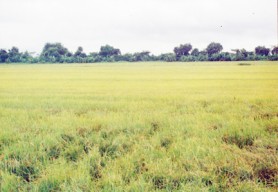Even as Guyana seeks to position its agricultural sector to respond to what is widely believed to be an impending global food crisis, there is increasing awareness of the challenges ahead for the sector as global concern mounts over climate change and its likely diverse impacts on food production.

If the assessment of the phenomenon of climate change and the various ways, both positive and negative, in which it is likely to impact the agricultural sector contained in the Ministry of Agriculture’s 2010 first quarter update is anything to go by, there is evidence that the government is not unaware of the challenges that lie ahead if its vision for the agricultural sector is to be realized.
“Climate change will affect agriculture, forestry and fisheries in complex ways, both positive as well as negative,” the first quarter 2010 agriculture update says. One aspect of the change will be a rise in global carbon dioxide concentrations in the atmosphere from 350 ppm to over 400 ppm by 2030. “Here,” the update says, “global warming may bring benefits for agriculture. The areas suitable for cropping will expand, the length of the growing period will increase, the costs of overwintering livestock will fall, crop yields will improve and forests may grow faster.” On the other hand, the report acknowledges that such gains as may accrue to the agricultural sector arising out of global warming must be set against the loss of fertile land to flooding, particularly in coastal areas. Reduced soil moisture levels in less well-watered areas, especially in the tropics, will render large areas unsuitable for cropping and some tropical grass lands may become increasingly arid. At the same time, “temperature rise will also expand the range of many agricultural pests and increase the ability of the pest population,” while, “in oceans, temperature rise may reduce plankton growth, bleach coral reefs and disrupt fish breeding and feeding patterns.”
The fact that agriculture is a major source of greenhouse gas emissions and is also responsible for up to half of all methane emissions, is also a challenge for a country which, for all its developmental aspirations that revolve around industrialization, oil production and an expanded manufacturing sector still regards agriculture as the bedrock of the country’s economy. Rice farming, the agricultural product, which perhaps more than any other, has earned the country its ‘bread basket’ image, is (apart from livestock), “the other main agricultural source of methane, accounting for about one-fifth of total anthropogenic emissions”. And while the Ministry of Agriculture’s update says that “emissions may grow more slowly because an increasing share of rice will be grown with better-controlled irrigation,” the point needs to be made that expanded rice cultivation and the expansion of the livestock industry are very much part of the grand design for the agricultural sector.
While there appears to be little concern that climate change will depress global food availability significantly, if at all, over the next three decades, there is, on the other hand, the likelihood that at least in some developing countries there may be increased need for security among vulnerable groups. Another concern that will arise in Guyana’s case is the likely impact of an expanded agricultural sector on the image which Guyana has sought as a friend of the environment.
While the Ministry of Agriculture’s First Quarter Update concedes that there are still “considerable uncertainties” in most of the projections regarding ways in which climate change will affect the environment and vice versa and that “the overall effect on global food production by 2030 is likely to be small,” it states, nonetheless, that a decline in agricultural yields linked to climate change is likely to occur in some developing countries by 2030.









